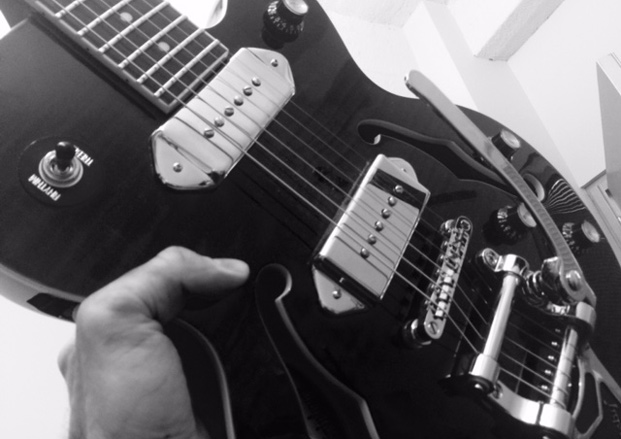Using Diatonic Power Chords and Inverted Borrowed Chords to Create More Musical Riffs

One of the most enjoyable things when learning to play the guitar can be writing your own music. This was the case for me when I first learned to play, and many of my students love to write their own music as well.
The difficulty in writing music as a beginner (or sometimes even as an experienced player) can lie in having a limited knowledge of chords and how they function within a key, or what a key even is.
What frequently happens for electric guitar players is that their chord progressions consist only of root-position power chords. This is not necessarily a bad thing, but understanding keys, scales and chords can make your writing much more intricate.
This riff-writing exercise will demonstrate how to create diatonic and borrowed chords based on a chromatic bass line while staying in key. For this example, I’m going to use the key of A minor and the harmonic minor scale as my guide for chord construction.

Here’s my bass line:

If I take each note of the bass line and create a root-position power chord, here’s what I’ll end up with: Besides having all parallel fifths, there are problems with the chords B5, C♯5 and D♯5. These all contain notes that don’t fit in the key of A minor with the root of the chord given.
But how do we know what chords fit? This diagram shows the diatonic chords within the key of A minor.

Notice all of the chords are built off of the A minor scale. Using just power chords, the fifth will be out of place in several instances. The B5 does not exist in this key, because B5 contains an F♯. C♯5 is incorrect as well, as the G♯ will only be used for the E (V) chord. With D♯5, the A♯ is also outside of the scale. This will very be problematic if you’re writing a melodic line in the key of A minor, as notes are going to clash with these three chords.
In the audio file, I’ve recorded a solo in A minor, and you can hear how notes will clash using all root-position power chords:
A simple way to make the appropriate chord move with the bass is to use an alternation of fifths and sixths:

Using this type of chord alternation with the chromatic bass line creates a very musical progression as several different types of chords are used (or implied). Obviously, the A5 fits. Creating an inverted G chord fits, and it makes a perfect transition to C5.
The A7 chord built off of C♯ is a borrowed chord called a secondary dominant. As it doesn’t fit in the key of A minor, if you look to the next chord of D5 and use that key for just that one chord, A7 becomes the dominant (V) chord in the key of D minor.
The exact same thing occurs with the B7 chord. The following chord is an E, so by borrowing that key temporarily, the dominant becomes B7. The final two chords are simply creating a suspension with the interval of a fourth resolving to a third (Esus to E) that can then be resolved back to an A5 chord.
Using the same solo as before, I’ve combined it with the proper chords for an A minor chromatic progression. Listen to the difference:
Having a working knowledge of music theory can make your musical canvas much easier to paint. It simply gives you a starting point from which to experiment.
Matthias Young teaches online guitar lessons at FreeGuitarVideos.com and is the Head of Guitar at Callanwolde Fine Arts Center in Atlanta, Georgia. His book, Metal Guitar Method, has sold thousands since its publication in 2012. Young, who has a bachelor's degree in music from Georgia State University, is pursuing a master of music degree at Boston University. If you’d like to study with Matthias over Skype, visit MatthiasYoung.com. You can follow Matthias on Facebook, Twitter, YouTube and Google+.
Get The Pick Newsletter
All the latest guitar news, interviews, lessons, reviews, deals and more, direct to your inbox!
Matthias Young has studied music performance and education at Berry College, Georgia State University, and Boston University. He’s published articles for Guitar World and The Guitar Foundation of America’s Soundboard. He is the author of several guitar methods, including the best-selling Metal Guitar Method and Guitar Quest: Essentials. If you’re interested in studying with Matthias, he offers online lessons over Skype, or you can learn from hundreds of videos from multiple instructors available at Guitar Compass.







![Joe Bonamassa [left] wears a deep blue suit and polka-dotted shirt and plays his green refin Strat; the late Irish blues legend Rory Gallagher [right] screams and inflicts some punishment on his heavily worn number one Stratocaster.](https://cdn.mos.cms.futurecdn.net/cw28h7UBcTVfTLs7p7eiLe.jpg)


